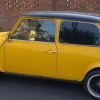Me being me did something different for those especially after replacing most of the metal fro fresh.
I made a stainless steel ring with four sealed captive anchor nuts riveted on then the whole thing bonded in place.
A great job.
Am I right in assuming that the large hole for the spigot is the same as original?
Also, I like you rivets, a proper job and essential to the design - form being function, where function is top notch.
I suspect those captive anchor nuts are superior to rivnuts. And I like the way its all on one removable plate rather than the captive nuts direct onto the body. Perfect for any necessary future front end work, even if its in thirty years time.
Did you do that because the pate is thicker than the bulkhead, so as to take the rivets? Or simply to make it a removable one piece plate, as being better by design?
I must steal the idea.Maybe I could weld the captive nuts onto the plate, (Answer: in that case simply use ordinary nuts , gosh I'm so stupid at times).
Very glad I raised this important trivial issue. Messrs Austin & Co., would be delighted with the outcome, I know.
It is sealed on but a decent thin scraper will easily remove it if require. I would be very hacked off if anything there started corroding again. A lot of prep work went into that area.
Thanks for diligent replies - every question answered. Appreciated. Yes, that prep work, and then what you do after..... and so its good you brought up the question of sealing.
I do appreciate seam sealant in in the context of spot welded seams, but otherwise I think of all possible methods, and have to say I am a fan of wet paint, where possible.
Otherwise I am considering using Threebond on places lie you mention, and on bulkhead plates. What do you think?















